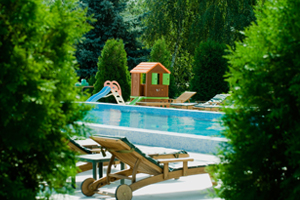


 In this article we explain the key aspects to your daily pool service routine. In order to keep your pool at its best, it pays to have a regular pool service routine. It doesn’t require hours of back-breaking labour, just monitoring of the pool, and its system, to make sure everything is running smoothly.
In this article we explain the key aspects to your daily pool service routine. In order to keep your pool at its best, it pays to have a regular pool service routine. It doesn’t require hours of back-breaking labour, just monitoring of the pool, and its system, to make sure everything is running smoothly.
As the water in your pool is constantly being re-circulated and re-used, it is important to keep it clean. There isn’t much to be done on a daily basis, but a few simple tests can help to keep the water at its healthiest.
1. Empty the skimmer baskets
Your filter is responsible for removing debris from the water as it flows through it. In order to keep everything running smoothly, it is ideal to empty the skimmer basket each morning as part of your daily service routine. You should do the same for each skimmer basket to keep the filter and pump functioning at their best.
(Your cartridge filters will also require cleaning at least once a season, we have dealt with this in a separate article entitled ‘servicing your filter’, which is available here.)
2. Test the water levels
Certainly during the summer months, when your pool is being used a lot, it is important to check the pH and santiser (typically chlorine) levels of your pool on a daily basis. The process is easy to carry out using a simple testing kit available from all good swimming pool suppliers.
The pH level of your pool relates to the acidity within your pool. You should check the pH as part of your daily pool service routine to ensure it falls within the ideal range. Where the test shows your pool’s pH is outside the ideal range, you will need to use pH balancing chemicals to stabilise the pH levels quickly in order to maintain the water in a healthy condition.
The ideal range for pH levels within a pool is typically between 7.2 and 7.6.
The chlorine levels in your pool should be kept high enough to resist the growth of bacteria. If the levels are too low you will have to chlorinate your pool by adding more chlorine throught the pools skimmer feeder, or directly into the water.
The ideal range for chlorine levels in your pool is between 1 and 4 ppm (parts per million).
We have prepared a separate article with more information on chemicals and your pool, which is available here.
3. Remove debris from the pool
During the summer months, or where the pool is left uncovered over long periods, it is likely that the pool itself may become littered with debris. You should check your pool each day to ensure it remains clean and pleasant to swim in. Although no lengthy cleaning process is likely to be required for the amount of debris that will find its way into your pool in one day it is best to keep up small daily actions to prevent it becoming a longer job.
There are two types of net that you should keep as part of your pool service kit; a deep leaf net, which has a wide opening and is ideal for removing leaves that have sunk to the pool floor (an extension pole can be used to access deeper parts of the pool) and a flat skimmer net, which is handy for removing leaves, flower, insects or other unwanted objects which may be floating on the pool’s surface. All items mentioned are available from your local pool store.
Your daily pool routine does not need to be an onerous task, by following these simple steps, in conjunction with a good weekly and monthly service routine, your pool will be the envy of your neighbourhood.
Is there anything you do on a daily basis to keep your pool sparkly clean and healthy which we’ve missed? Feel free to leave us a comment in the box below? For more information on pool supplies or service contracts please contact a pool supplier using the link above.